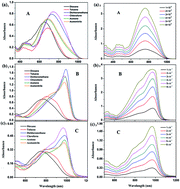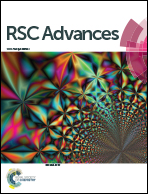Microwave-assisted synthesis of novel julolidinyl-based nonlinear optical chromophores with enhanced electro-optic activity†
Abstract
Under microwave (MW) irradiation at a proper temperature, three chromophores (A, B, C) with julolidinyl-based donors and TCF or CF3-Ph-TCF acceptors have been synthesized in high overall yields compared with the conventional heating method. The introduction of a MW heating approach in the synthesis of these chromophores proved to markedly shorten reaction times, reduce by-products and increase the efficiency. The solvatochromic behavior and cyclic voltammetry (CV) measurements suggested that chromophores B and C with stronger acceptors can be more easily polarized with respect to chromophore A. The solvent dependence of the relevant theoretical parameters including dipole moment (μ), first-order polarizability (α), hyperpolarizability (β) and bond-length alternation (BLA) of all chromophores were also studied by DFT calculations. All these chromophores showed good thermal stability and large β values. In an electro-optic (EO) activities test, the guest–host poled polymer A/APC exhibited the highest EO coefficient (r33) of 192 pm V−1 at 1.31 μm. The MW-assisted syntheses and systematic analyses afforded a rational design for NLO chromophores, and provided a new method to optimize the structures of the chromophores to achieve higher r33 values.


 Please wait while we load your content...
Please wait while we load your content...